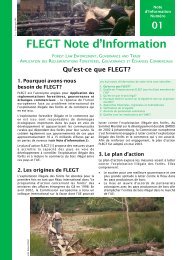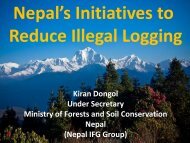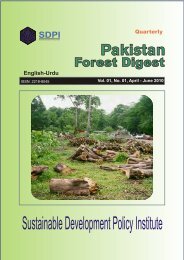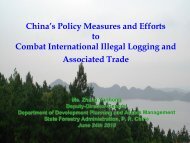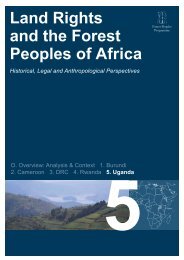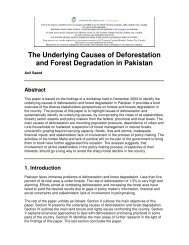CHAINSAW MILLING IN GHANA: CONTExT, DRIVERS ... - Fornis.net
CHAINSAW MILLING IN GHANA: CONTExT, DRIVERS ... - Fornis.net
CHAINSAW MILLING IN GHANA: CONTExT, DRIVERS ... - Fornis.net
- No tags were found...
Create successful ePaper yourself
Turn your PDF publications into a flip-book with our unique Google optimized e-Paper software.
Chapter 6. Conclusions and policy recommendationsThe VPA process in Ghana has adopted a multi-stakeholder dialogue approach.Through this approach, it has addressed the legality assurance system, timberprocurement policies, and regularization of the supply of legal timber to thedomestic market, among other topics.The EU-TBI chainsaw-milling project, “Developing alternatives for illegal chainsawmilling in Ghana and Guyana through multi-stakeholder dialogue,” is facilitating amulti-stakeholder dialogue in Ghana. In this process all stakeholders participate indecision making. They are supported by sound information that informs them andenables them to weigh the merits of various options. By addressing illegality in thedomestic market, this process is supporting the VPA process in Ghana. It may behelpful to adopt one multi-stakeholder process with multiple sources of funding andsupport to focus on the key policy issues. This will optimise stakeholder energies andmay be more efficient in addressing the core issues and policy options for CSM.A number of other conditions must be met for any policy to be successful. Freehandchainsaw milling is considered to be incompatible with any of these options:• Apply and enforce a scientifically supported sustainable AAC throughout theforest estate, in particular the Forest Reserves.• Stimulate tree growing on farms and in plantations to increase future supply.• Since any option will lead to a reduction of opportunities in the chainsawsubsector, there will be a need to provide efficient and competitive alternativelivelihoods for displaced chainsaw operators.• Register and provide a code of conduct for all lumber traders/dealers.• Improve rural community access to timber for non-commercial use by artisanalpractices through leases or other forms of user rights.• Optimise the harvest of yield allocation.• Ensure that statutory fees are paid (and collected) regularly and promptly.• Enhance the capacity of the Forestry Commission in forest monitoring.• Improve mechanisms for involving rural communities in forest monitoring.• Establish mechanisms to induce political will for policy implementation.• Improve benefit sharing of timber revenue to include farmers.• Formalise cross border trade with industry.• Mount a vigorous consumer campaign against freehand chainsawn lumber.• Introduce a public timber procurement policy.The strategy to reduce this practice will depend on the policy options selected. Ageneral timber harvesting and trade improvement policy arrangement must be inplace to enable any of the specific policy options to work as expected.Apart from the general conditions mentioned above, a number of specific conditionsas listed in Table 22 would have to be met. These conditions would have to be discussedand evaluated by a broader stakeholder group (multi-stakeholder dialogue),in terms of what each would cost and what their implications would be.Furthermore, the multi-stakeholder dialogue should identify specific actions toaddress the drivers of CSM in light of the recommended policy options.53





